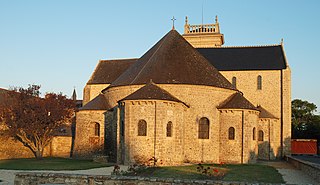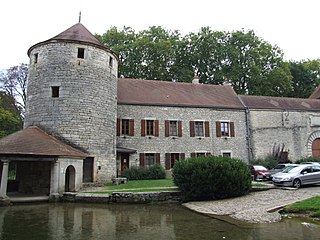This article needs additional citations for verification .(July 2016) |
Saint Felix of Rhuys (died 1038) was a Breton Benedictine hermit and abbot, who re-founded Saint-Gildas-de-Rhuys Abbey.
This article needs additional citations for verification .(July 2016) |
Saint Felix of Rhuys (died 1038) was a Breton Benedictine hermit and abbot, who re-founded Saint-Gildas-de-Rhuys Abbey.
Felix was born of wealthy parents in Quimper around 970. [1] He had a great regard for Saint Paul Aurelian who had built a monastery at Lampoul on Ushant, and whose relics, around 960, had been translated to Fleury Abbey. Felix became a recluse on Ushant. He left his hermitage during the Norman invasions to take refuge at Fleury in Saint-Benoît-sur-Loire, where he was welcomed by Abbo of Fleury.
Geoffrey I, Duke of Brittany asked the Abbot of Fleury to re-establish Rhuys Abbey, [2] which had been founded by Saint Gildas in the 6th century on the Gulf of Morbihan, and had been destroyed by the Normans. Father Abbot entrusted Felix with the task of rebuilding. The original abbey had been built in wood on the remains of a Roman oppidum; Felix built in stone. Begun in 1008, the reconstruction ended in 1032 with the consecration of the church by Judicaël, bishop of Vannes and brother of the Duke. Félix died on March 4, 1038. [3]
His feast day is 4 March.

The Abbey of the Paraclete was a Benedictine monastery founded by Peter Abelard in Ferreux-Quincey, France, after he left the Abbey of St. Denis about 1121. Paraclete comes from the Greek word meaning "one who consoles" and is found in the Gospel of John (16:7) as a name for the Holy Spirit.

Gildas — also known as Gildas the Wise or Gildas Sapiens — was a 6th-century British monk best known for his scathing religious polemic De Excidio et Conquestu Britanniae, which recounts the history of the Britons before and during the coming of the Saxons. He is one of the best-documented figures of the Christian church in the British Isles during the sub-Roman period, and was renowned for his Biblical knowledge and literary style. In his later life, he emigrated to Brittany where he founded a monastery known as Saint-Gildas-de-Rhuys.

Déols is a commune in the department of Indre, region of Centre-Val de Loire, central France.

Île-d'Arz is an archipelago of nine islands and a commune in the Morbihan department, Brittany, northwestern France, only 6 kilometres to the southwest of Vannes.

The Abbey of Saint-Étienne, also known as Abbaye aux Hommes by contrast with the Abbaye aux Dames, is a former Benedictine monastery in the French city of Caen, Normandy, dedicated to Saint Stephen. It was founded in 1063 by William the Conqueror and is one of the most important Romanesque buildings in Normandy.

Fleury Abbey (Floriacum) in Saint-Benoît-sur-Loire, Loiret, France, founded in about 640, is one of the most celebrated Benedictine monasteries of Western Europe, and possesses the relics of St. Benedict of Nursia. Its site on the banks of the Loire has always made it easily accessible from Orléans, a center of culture unbroken since Roman times. In 2010, the abbey had over forty monks led by the abbot Etienne Ricaud.

Ligugé Abbey, formally called the Abbey of St. Martin of Ligugé, is a French Benedictine monastery in the Commune of Ligugé, located in the Department of Vienne. Dating to the 4th century, it is the site of one of the earliest monastic foundations in France. The original abbey having been destroyed during the French Revolution, the current monastic community dates from 1853, and belongs to the Solesmes Congregation.

Micy Abbey or the Abbey of Saint-Mesmin, Micy, sometimes referred to as Micy, was a Benedictine abbey near Orléans at the confluence of the Loire and the Loiret, located on the territory of the present commune of Saint-Pryvé-Saint-Mesmin. Since 1939 it has hosted a community of Carmelites

Saint-Gildas-de-Rhuys is a commune in the Morbihan department of Brittany in north-western France. Inhabitants of Saint-Gildas-de-Rhuys are called in French Gildasiens.
The Abbey of Saint-Evroul or Saint-Evroul-sur-Ouche is a former Benedictine abbey in Normandy, located in the present commune of Saint-Evroult-Notre-Dame-du-Bois, Orne, Normandy. It has been classified as a historical monument since 1967. Its name refers to its founder, Ebrulf (Evroul), who founded a hermitage in the forest of Ouche around 560. The abbey was rebuilt around 1000.

Glanfeuil Abbey, otherwise the Abbey of St Maurus, was a French Benedictine monastery founded in the 9th century in the village of Saint-Maur-sur-Loire, located in what is now the commune of Le Thoureil, Maine-et-Loire.

Redon Abbey, or Abbey of Saint-Sauveur, Redon, in Redon in the present Ille-et-Vilaine, Brittany, France, is a former Benedictine abbey founded in 832 by Saint Conwoïon, at the point where the Oust flows into the Vilaine, on the border between Neustria and Brittany.

Moissac Abbey was a Benedictine and Cluniac monastery in Moissac, Tarn-et-Garonne in south-western France. A number of its medieval buildings survive including the abbey church, which has a famous and important Romanesque sculpture around the entrance.

The Abbey of St. Vincent, Laon was a Benedictine monastery in Laon, Picardy, northern France.

The Bèze Abbey, was a monastery founded in 629 AD in Burgundy, France. It was destroyed several times during the next three centuries by Frankish warlords, Saracens, Normans and Hungarians. At the end of the 10th century the abbey was re-founded and entered a golden age for the next two centuries. By the 13th century the spiritual life of the abbey had declined and the monks were mainly concerned with temporal matters. The abbey lost most of its monks during the Hundred Years' War and the Black Death of the 14th century. In 1429 it was fortified with stone walls, a moat and towers, two of which have survived. The abbey was again devastated by feuds in 1513, by the French Wars of Religion (1562–98) and by the Thirty Years' War (1618–48).

Bernay Abbey was a Benedictine abbey in Bernay, Eure, France. The designers of its abbey church were ahead of their time, making it one of the first examples of Romanesque architecture in Normandy. It shows the early evolution of that style, its decorative elements and its building techniques.
Olivier Delourme (1660–1729), nicknamed "the architect of Brittany", was a French architect of the "Grand Siècle" renowned for his many achievements still existing, mainly in Morbihan.

Buzay Abbey, dedicated to Our Lady, was a Cistercian Abbey at Rouans in Pays de la Loire, France, formerly in Brittany, founded in 1135 and dissolved in 1790.

Solignac Abbey, or the Abbey of Saint-Peter and Saint Paul of Solignac, is an abbey in Solignac, near Limoges, in Haute-Vienne. It was founded around 631 AD by Saint Eligius (Éloi). The present buildings date to the 12th century, but have been modified many times since then. The abbey was dissolved during the French Revolution and the buildings were put to new uses, including a prison, boarding school, porcelain factory and seminary. As of 2021 there were plans to restore it back to its original function as a monastery.

Saint Bieuzy was a 6th-century Breton hermit and companion of Saint Gildas who gave his name to the villages of Bieuzy and Bieuzy-Lanvaux, both in Morbihan. His name probably comes from the Old Breton biu, bihui, "living". His feast day is 24 November.